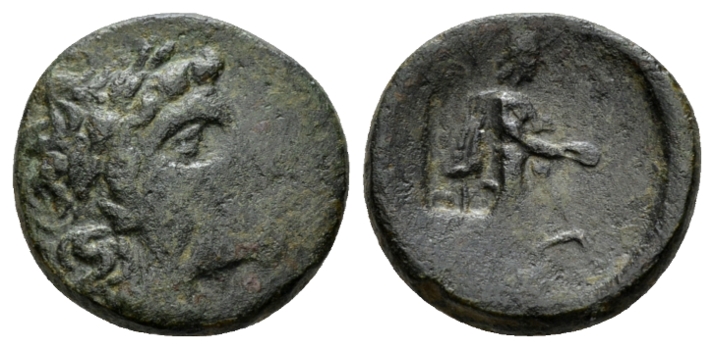S 1876 - Opous (Locrians), bronze (Apollo/Hero Opus) (100-50 BCE)
From SILVER
100 BCE - 50 BCE Bronze
Description
| ObverseInscription or printing placed on the obverse.: | Head of Apollo laureate, r. |
| ReverseInscription or printing placed on the reverse.: | OPOYNTIΩN (Greek).Male figure standing r., draped, holding spear over shoulder and patera in extended r., snake at his feet |
Mint and issuing power
| MintIdentifies the place of manufacture or issue of a numismatic object.: | Opous | Ancient regionAncient region.: | Locri Opuntii (Opus) | Modern countryModern country: Greece | AuthorityIdentifies the issuing power. The authority can be "pretended" when the name or the portrait of X is on the coin but he/she was not the issuing power. It can also be "uncertain" when there is no mention of X on the coin but he/she was the issuing power according to the historical sources: |
Chronology
| FromIdentifies the initial date in a range assigned in a numismatic context. | 100 BCE | toIdentifies the final date in a range assigned in a numismatic context.. | 50 BCE | PeriodTime period of the numismatic object.: Hellenistic 323-30 BC |
Physical description
| MetalThe physical material (usually metal) from which an object is made.: | Bronze |
Median weightMedian of the weights of numismatic objects (in grams). in grams | 5.50 | DenominationTerm indicating the value of a numismatic object. Examples: tetradrachm, chalkous, denarius.: | StandardStandard.: |
Image

S1876 Lokrians bronze Apollo standing man.jpg [1]
References
| Die study referencePublication of the study: | Morineau Humphris - Delbridge 20141Morineau Humphris - Delbridge 2014, p. 162 | ||
| Coin series referenceReference to coin series study: | |||
| Coin series web referenceCoin series web references: | |||
Obverse dies distribution
| FrequencyFrequency of specimen in distribution. ᵖ | Number of obversesNumber of obverse dies. ᵖ (o) | % (o) | Number of coinsNumber of coins. (n) | % (n) | Die nameName(s) of the die(s). |
| 3 | 2 | 66.67 | 6 | 35.29 | 2, 3 |
| 11 | 1 | 33.33 | 11 | 64.71 | 1 |
| Total | 3 of 3 | 100 | 17 of 17 | 100 |
Reverse dies distribution
no distribution is available
Quantification
| Number of obversesNumber of obverse dies. ᵖ (o) | 3 | Number of singletons (o1)The number of singleton coins. ᵖ | |
| Number of reverse diesNumber of reverse dies. (r) | 2 | Number of coinsNumber of coins. (n) | 17 |
| Coins per obverse dieNumber of coins per obverse die. (n/o) | 5.67 | Coins per reverse dieNumber of coins per reverse die. (n/r) | 8.5 |
| Reverse per obverse ratioRatio of obverse dies divided by reverse dies. (r/o) | 0.67 | Percentage of singletons (o1)number of coins (n) divided by the number of singletons (o1) ᵖ | % |
| Original number of dies (O) (Carter 1983 formula)The estimation of the number of coins according to Carter 1983 ᵖ | 3.26 | Coins struck if 20,000 as average productivity per dieCoins made if the average productivity for obverses (according to Carter) is 20,000. ᵖ | 65,200 |
| Original number of dies (O) (Esty 2011 formula)The estimation of the number of coins according to the singleton formula in Esty 2011 ᵖ (O) | 3.64 | Survival rate if 20,000 as average productivity per dieSurvival rate if average productivity is 20,000. ᵖ | 0.00026 |
| Coverage (o = % of O) (Esty 1984 formula)Esty 1984 - coverage (% of O) ᵖ (o = % of O) | % | Die productivity if survival rate 1/2,000Average productivity if survival rate is 1/2,000. ᵖ | 10,429.45 |
| Weight of silver (in kg) if 20,000 coins per die (O = Carter formula)Carter 1983 * Median weight * 20000 (*10 if gold or electrum) ᵖ | n.a. | Die productivity if survival rate 1/5,000Average productivity if survival rate is 1/5,000. ᵖ | 26,073.62 |
Remarks
Most likely one single workstation
References
- ^ Morineau Humphris, Jacqueline - Delbridge, Diana (2014), The Coinage of the Opuntian Lokrians, RNS Spec. Publ. 50, London, RNS, 264 p., 61 pl.